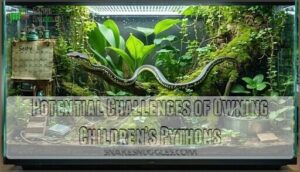This site is supported by our readers. We may earn a commission, at no cost to you, if you purchase through links.

Their glossy reddish-brown scales and leaf-shaped markings catch light beautifully, yet their care demands precision—temperature gradients, humidity levels, and feeding schedules aren’t suggestions but requirements for their 20-30 year lifespan.
The real question isn’t whether they’re manageable in size, but whether you’re prepared to maintain exacting environmental conditions for two decades while interacting with a snake whose temperament can swing from docile to defensive without warning.
Table Of Contents
- Key Takeaways
- Appearance of Children’s Pythons
- Lifespan of Children’s Pythons
- Care Requirements for Children’s Pythons
- Behavior and Temperament of Children’s Pythons
- Handling Children’s Pythons
- Advantages of Children’s Pythons as Pets
- Potential Challenges of Owning Children’s Pythons
- Proper Socialization for Children’s Pythons
- Considerations Before Getting a Children’s Python
- Frequently Asked Questions (FAQs)
- Conclusion
Key Takeaways
- Children’s Pythons reach only three to four feet in length, making them genuinely manageable for apartment living, but their compact size masks demanding care requirements including precise temperature gradients (88-90°F basking, 78-80°F cool end), 50% humidity maintenance, and consistent environmental monitoring throughout their 20-30 year lifespan.
- These pythons aren’t beginner-friendly despite their small stature—they require scientific precision in husbandry, with improper temperature or humidity triggering respiratory infections quickly, and their temperament can shift unpredictably from docile to defensive, particularly during feeding or shedding cycles.
- The long-term financial commitment extends well beyond the $70-300 purchase price, with initial setup costs of $200-500, annual veterinary visits ranging $75-200, ongoing substrate replacement, and decades of consistent weekly feeding and daily maintenance requirements.
- Success with Children’s Pythons demands treating their care like a controlled experiment rather than a casual hobby, accepting that proper socialization reduces stress but won’t guarantee reciprocal affection, and recognizing that legal restrictions, permit requirements, and Salmonella transmission risks add layers of responsibility beyond basic animal care.
Appearance of Children’s Pythons
When you first lay eyes on a Children’s Python, you’ll notice its reddish-brown body decorated with darker, leaf-like markings that run from head to tail. These patterns vary slightly among individual Antaresia childreni, creating subtle color variations that make each snake unique. The scale texture appears smooth and glossy, especially after shedding.
Young specimens display brighter hues that gradually darken with age, revealing distinctive pattern development through successive sheds. At maturity, the average Children’s Python size reaches three to four feet—considerably smaller than most python species. This size comparison makes them manageable for hobbyists interested in snake morphs without requiring massive enclosures.
The characteristics of Children’s Pythons extend beyond aesthetics; their markings provide excellent camouflage against rocky outcrops and leaf litter in their native Australian habitat, allowing these ambush predators to blend seamlessly into their surroundings.
Lifespan of Children’s Pythons
Beyond their striking appearance, Children’s pythons offer something even more noteworthy: a potential three-decade partnership that few other pet reptiles can match. With proper husbandry, these Australian natives commonly reach 20-30 years in captivity, and longevity records document specimens exceeding this maximum age. This extended snake lifespan represents a serious commitment—you’re not purchasing a short-term companion.
Children’s pythons offer a remarkable three-decade partnership that few other pet reptiles can match
Several factors affecting their lifespan deserve your attention:
- Consistent environmental conditions prevent stress-related illness
- Proper nutrition throughout their life stages bolsters healthy aging
- Regular veterinary monitoring catches issues before they become critical
- End-of-life care guarantees dignity during their final years
Understanding the average lifespan helps you prepare financially and emotionally for decades of responsibility.
Care Requirements for Children’s Pythons
Setting up a proper environment for your Children’s Python isn’t complicated, but getting the details right makes all the difference. From the enclosure itself to temperature control and feeding schedules, each element plays a role in keeping your snake healthy.
Here’s what you need to know to create a suitable home for your pet.
Enclosure Size
For an adult Children’s Python, you’ll want an enclosure measuring at least three feet long, two feet wide, and two feet high—roughly the size of a standard 40-gallon tank. These minimum dimensions allow adequate space for movement and thermoregulation.
Your snake enclosure size should include:
- Vertical space for climbing branches
- Hiding spaces at both temperature zones
- Enrichment items without overcrowding
Proper Children’s python enclosure setup provides room for future growth while preventing stress.
Habitat Setup
Once you’ve secured the right-sized enclosure, the real work begins—turning that empty box into a habitat your python will actually thrive in. Your Children’s python enclosure setup requires three foundational elements: appropriate substrate options, adequate hiding places, and climbing space for natural behavior.
| Setup Component | Recommended Options | Purpose |
|---|---|---|
| Substrate | Aspen shavings, coconut fiber, cypress mulch | Maintains humidity, allows for burrowing |
| Hides | Cork bark, reptile caves, plant cover | Provides security at each temperature zone |
| Climbing Features | Branches, sturdy vines, textured backgrounds | Encourages exercise, mental stimulation |
Enclosure enrichment doesn’t need to break the bank—sterilized natural branches work beautifully. This habitat setup for snakes creates the temperature gradient your python needs while supporting instinctive behaviors like exploration and retreat.
Temperature & Lighting
Getting the temperature dialed in correctly isn’t optional—it’s the difference between a thriving python and a sick one. Your enclosure needs a thermal gradient: a basking spot reaching 88-90°F and a cooler end around 78-80°F. Night temperatures can safely drop to 75°F.
Heat sources like under-tank heaters or ceramic bulbs work well, though UVB lighting isn’t strictly necessary. Maintain this lighting schedule consistently—your python’s metabolism depends on it.
Humidity
Humidity mightn’t seem critical at first glance, but letting it drop too low can turn shedding into a frustrating ordeal for your python. Aim for humidity levels around 50%—use a hygrometer to track it accurately. When shedding approaches, you can lightly mist the enclosure to boost moisture.
Consistent humidity maintenance for snakes also promotes respiratory health, preventing infections that thrive in overly dry conditions.
Water
Fresh, clean water isn’t just a convenience for your Children’s python—it’s a lifeline that aids hydration, thermoregulation, and overall health. You’ll need a sturdy water bowl large enough for soaking, which aids shedding and helps maintain humidity levels.
Replace the water daily to guarantee quality, and scrub the bowl regularly to prevent bacterial buildup. Watch your python’s drinking habits—frequent soaking or extended time near the water source can signal hydration needs or environmental adjustments required.
Food & Diet
Feeding your Children’s python the right diet isn’t guesswork—it’s about matching prey size to your snake’s girth and establishing a consistent schedule that mirrors their natural hunting rhythm. Here’s what you need to know about the Children’s python diet:
- Prey size: Offer rodents no larger than the widest part of your snake’s body
- Feeding frequency: Feed juveniles every 5-7 days; adults every 10-14 days
- Frozen rodents: Thaw prey items completely and warm to room temperature before feeding
- Dietary supplements: A varied diet of appropriately-sized mice or rats provides complete nutrition
Your python’s wild diet consists primarily of small mammals and lizards, but captive feeding with frozen rodents reduces parasite risk and assures consistent nutrition.
Potential Health Concerns
Though Children’s pythons are hardy, they’re not bulletproof against health concerns. Respiratory infections from improper humidity or temperature can cause wheezing, nasal discharge, and lethargy. Parasite infestations—especially mites around the eyes and cloaca—thrive in unclean enclosures. Shedding issues arise when humidity drops too low, leaving stuck skin that invites infection. Stress-related illness weakens their immune system, while zoonotic risks like Salmonella demand careful handwashing.
Preventing snake health issues starts with clean enclosures, proper environmental controls, and regular veterinary checkups. These snakes are known for their generally calm temperament, but stress can still impact their health.
Behavior and Temperament of Children’s Pythons
Children’s pythons are largely solitary creatures—outside breeding season, they spend over 90% of their time alone. Their temperament is generally calm, though individual variation means some are bolder or more defensive than others. Understanding their behavior helps you anticipate their needs and responses. These snakes are part of the Pythonidae family, a group of nonvenomous snakes.
Key behavioral traits include:
- Nocturnal activity patterns – They’re most active after dusk, with 85–90% of movement occurring at night.
- Strong feeding response – Around 35% show excitement at feeding time, which can lead to mistaken strikes if you touch them right before or after meals.
- Defensive behaviors in juveniles – Younger snakes are more prone to defensive biting, though this decreases markedly with regular, respectful interaction.
- Stress sensitivity – Newly relocated pythons or those in inadequate setups show 25% higher stress behaviors, including refusal to eat and increased hiding.
Their behavior is predictable once you learn their rhythms, making the Children’s Python temperament manageable for attentive keepers.
Handling Children’s Pythons
Once you’ve learned to read your python’s behavioral signals, the next step is learning how to interact with them without triggering stress or defensive reactions. Children’s python interaction requires supporting their entire body—never let them dangle unsupported. Start with brief five-minute sessions twice weekly, gradually increasing frequency as your snake grows comfortable. Avoid interacting during shedding or within 48 hours of feeding, when bite risk increases considerably. Watch for stress indicators: rapid tongue flicking, muscular tension, or attempts to retreat signal you should return them to their enclosure.
Safe techniques for snake interaction include:
- Approach from the side rather than above (mimics predator behavior), gently scoop under the mid-body, and let them move freely across your hands while maintaining secure support—never restrain their head unless medically necessary, as this triggers defensive behavior and diminishes trust-building progress.
Advantages of Children’s Pythons as Pets
Beyond the careful holding techniques, Children’s pythons offer several practical advantages that make them stand out among pet reptiles. Their common size—usually three to four feet—means you won’t need massive enclosures or specialized housing modifications. This beginner-friendly species thrives in 20-gallon tanks, making them ideal for apartment dwellers or those with limited space.
Their docile nature translates to fewer defensive strikes compared to larger constrictors, reducing apprehension for new caretakers. As low-maintenance pets, they eat only once weekly and don’t require daily interaction, fitting seamlessly into busy schedules. These quiet companions produce no vocalizations, eliminating noise concerns entirely.
The advantages of Children’s pythons as pets extend beyond convenience—their 20-30 year lifespan allows you to develop genuine bonds with these intelligent animals. They recognize regular caregivers, adapt to routines, and display individual personalities that make each snake unique. For beginners seeking a reptile that balances accessibility with engagement, Children’s pythons deliver great value.
Potential Challenges of Owning Children’s Pythons
While Children’s pythons rank among easier reptiles to keep, you’ll still face real ownership hurdles. Their 20-30 year lifespan demands decades of commitment—far beyond most pets. Health concerns like respiratory infections and mites require vigilant enclosure maintenance and regular vet visits. Temperature or humidity mistakes can trigger health issues quickly. Some individuals display temperament shifts as they mature, becoming less predictable during feeding or shedding cycles. Interaction issues may arise if your python refuses food or exhibits defensive behaviors you weren’t expecting.
- Long-term dedication: This isn’t a short-term hobby—you’re signing up for potential challenges of ownership spanning three decades, through job changes, relocations, and life transitions.
Proper Socialization for Children’s Pythons
Despite the challenges you’ll encounter, your Children’s python won’t thrive without consistent, positive interaction from its first weeks home. Start with brief sessions—five to ten minutes—two to three times weekly, allowing gradual introduction to human contact. Watch for stress signals: rapid tongue flicking, muscular tension, or attempts to retreat indicate you’re pushing too fast.
Interaction frequency matters less than quality; rushed or forceful interactions damage trust permanently. Environmental enrichment complements socialization—branches, hides, and varied textures let your python express natural behavior between interaction sessions.
As temperament stabilizes with age, you’ll recognize cues that signal readiness for interaction versus times when your snake needs space. Proper interaction and socialization reduce stress responses, creating a python comfortable with routine husbandry rather than one that views every enclosure opening as a threat.
Considerations Before Getting a Children’s Python
Before committing to a Children’s python, you’ll need to evaluate several practical realities that extend far beyond the initial decision. These considerations directly affect your ability to provide adequate Children’s python care throughout the snake’s remarkably long life.
Critical factors to assess include:
- Legal aspects: Verify local regulations, as permits may be required, and some jurisdictions restrict exotic pet ownership with significant penalties for noncompliance.
- Financial burden: Expect $200–$350 for purchase, over $1,000 for initial setup, and ongoing costs, including $75–$200 annual veterinary visits and monthly substrate replacement.
- Time commitment: A 20–30 year lifespan demands decades of consistent care, including weekly feeding, daily water changes, and regular enclosure maintenance.
- Health risks: Respiratory infections and snake mites require vigilant monitoring, while Salmonella transmission necessitates strict hygiene protocols after contact.
- Owner suitability: Assess whether your lifestyle accommodates temperature gradients (29–32°C basking, 24–27°C cool end), 50–60% humidity maintenance, and proper enrichment provisions.
Understanding both the advantages of Children’s Pythons—their docile temperament and manageable size—and the potential challenges of owning them, particularly the long-term responsibility, ensures that ethical considerations of pet ownership guide your decision rather than impulse.
Frequently Asked Questions (FAQs)
Are Childrens Pythons legal to own everywhere?
No, ownership legality varies greatly by jurisdiction. Local regulations and exotic pet laws differ across states, countries, and municipalities, with some requiring permit requirements or banning pythons entirely. Interstate transport may face restrictions.
Research your area’s laws before acquiring one to guarantee responsible pet ownership and animal welfare compliance.
How much does a Childrens Python cost?
Like a telegram from days past, the Childrens Python cost arrives quickly: initial purchase ranges from $70-$300 depending on availability.
Setup costs add another $200-$500 for enclosure essentials, while food expenses and veterinary care create modest long-term costs.
Can Childrens Pythons live with other snakes?
No, Children’s pythons shouldn’t live with other snakes. Cohabitation risks include disease transmission, competition for resources, and stress from temperament clashes. These solitary hunters require individual enclosures and proper quarantine protocols to thrive.
Do Childrens Pythons bite frequently or aggressively?
Children’s pythons rarely bite and show minimal aggression. Their docile temperament makes bite frequency low, with bite severity posing little concern.
Defensive behavior often stems from stress during improper interaction or feeding time. Respecting their space prevents triggering defensive responses.
Where can I purchase a Childrens Python?
You can purchase Children’s pythons through reputable local breeders, reptile expos, or licensed online retailers. Ethical sourcing is critical—verify breeder credentials and avoid wild-caught specimens. Pet stores occasionally stock them, though availability varies.
Snake prices usually range from $75 to $200 depending on age and morph.
Conclusion
Like Goldilocks discovering the perfect porridge, you’ll find Children’s Pythons occupy a manageable middle ground—compact enough for apartment life yet demanding enough to test your commitment.
Do Children’s Pythons make good pets? Only if you’re prepared to honor precise environmental parameters for decades while respecting a temperament that won’t always reciprocate your affection. They’re not beginner-friendly despite their size; they’re specialists disguised as small snakes.
Success requires treating husbandry like a science experiment, not a hobby.
- https://www.nationalgeographic.com/animals/article/ball-pythons-west-africa-exports
- https://reptilehow.com/angolan-python-size/
- https://www.healthline.com/health/ball-python-bite
- https://a-z-animals.com/animals/childrens-python/
- https://pawfectjourney.com/exotic-pets/snakes/childrens-pythons-antaresia-childreni/














